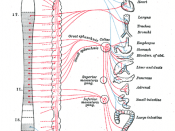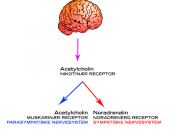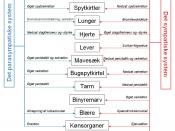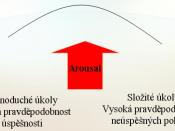In Help for the Helper, the author aims at clarifying concepts such as burnout and distress. The importance of self-care is emphasized throughout the book. A major component of mental self-care relates to the concept of arousal awareness. The autonomic nervous system (ANS) regulates the arousal level of the individual; therapists working under very stressful situations might suffer form an involunteer elevation of the arousal level that might jeopardize clear thinking. In the third chapter of the book, Rothschild begins a biological analysis of the autonomic nervous system, its components, and reactions.
The autonomic nervous system adjusts the function of virtually all organ systems and we refer to it as being an involuntary unit. Blinking, heartbeat, and breathing are just a few of the function of the autonomic nervous system. Without this highly evolved and advance system, we would not be able to control and organize our bodies and our minds.
The ability to breath, think, feel, and being emotionally alive, is strictly connected to the correct functioning of the ANS.
This chapter of the book also deals with some important instruments whose role is to identify the level of arousal. Body awareness is considered the most important tool for recognizing the intensity of such arousal. Therapists could benefit from recognizing their level of arousal and should try to find the proper intensity in order to perform at their best. As I study to become a licensed counselor, I intend to practice utilizing the different techniques available in order to manage my arousal level and especially to avoid burnout. Going to school full time, supporting a family, and still working forty hours a week, is a good motivator to practice the different advices described in the chapter.
The author illustrates a few practical exercises aimed at developing awareness of our bodies and minds. Such awareness serves the purpose of recognizing the proper arousal level. There are several skills that can be learned in order to evaluate and adjust the level of arousal to better control bodily boundaries. These exercises should be completed in sequence and include a simple body awareness session where the person would practice how to sharpen the awareness of changes in the body systems. Therapists should apply ÃÂin sessionÃÂ arousal control and arousal tracking techniques in order to better manage their reactions, compliance, and resistance to compassion fatigue, vicarious traumatization, and burnout. A series of muscular exercises are also listed in the chapter as a form of body awareness practice. Both relaxation and tension exercises can be performed in order to find the appropriate level of arousal. Trying to reach a higher level might be necessary when attempting to enhance drive, assertiveness, and focus. After the initial understanding of the Autonomic Nervous System, arousal level, and body awareness, the therapist should practice what the author refers to as ÃÂputting on the brakesÃÂ (Rothschild, 2005). Being able to recognize the proper level of arousal and keep such level stable would be a requirement for any counselor in order to optimally manage the therapy sessions.
The information included in the reading together with my previous studies in sport psychology, will be very useful in terms of managing my anxiety levels and preventing burnout. I believe that most of the times, just some simple breathing exercises can reduce the level of stress and improve a correct brain function. I often engage in simple stress reduction exercises when I feel overly anxious or when my level of arousal reaches unhealthy levels. I find this practice helpful during a sport activity such as tennis or golf and also during everyday life situations that might be stress inducing. At this stage of my life, I often feel stressed and pressured by the various deadlines that school and work bring. I often feel as if there are not enough hours in each day to accomplish all the different tasks necessary. Tracking the level of ANS arousal and learning how to manage it would help me deal with the above mentioned deadlines and with the general stress that a busy life can create.
An optimal level of arousal would be ideal in order to better perform in any stress inducing situation. This level can be thought as the most favorable level of motivation or anxiety. During my previous studies in the field of Sport Psychology, I recall learning that if a person is able to reach a perfect level of anxiety, he or she would be able to reach the best level of motivation. Dedication, focus, and motivation are just some of the qualities that are necessary for a person to succeed while trying to accomplish different tasks. I plan to utilize the information learned in the book ÃÂHelp for the helperÃÂ to manage my anxiety level and control stress.
Being a therapist and dealing with very serious issues can be stressful and sometimes even traumatic. The therapistÃÂs personality traits play an important role on the possibility of experiencing burnout. Some people might be more prone to feel stress and anxiety. I am the type of person that could suffer from such feelings. I intend to apply relaxation techniques and arousal-level monitoring to my current lifestyle and I am determined to become proficient before entering the professional counseling world.
ReferencesRothschild, B. (2005, February). Applying the brakes. Counselling & Psychotherapy Journal, 16(1), 12-16. Retrieved October 2, 2008, from Academic Search Complete database.
Rothschild, B. (2006). Help for the helper. W.W. Norton & Company.





